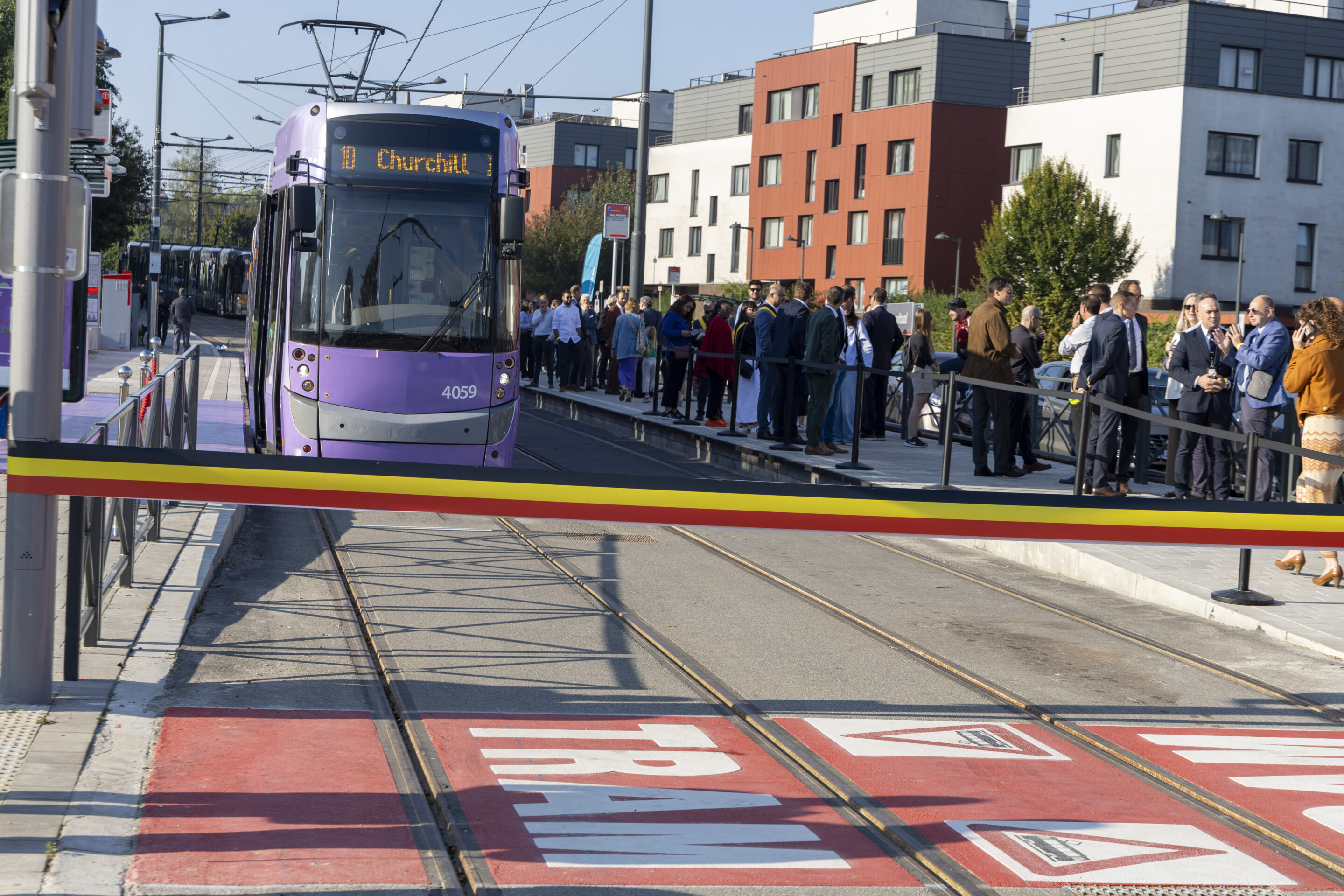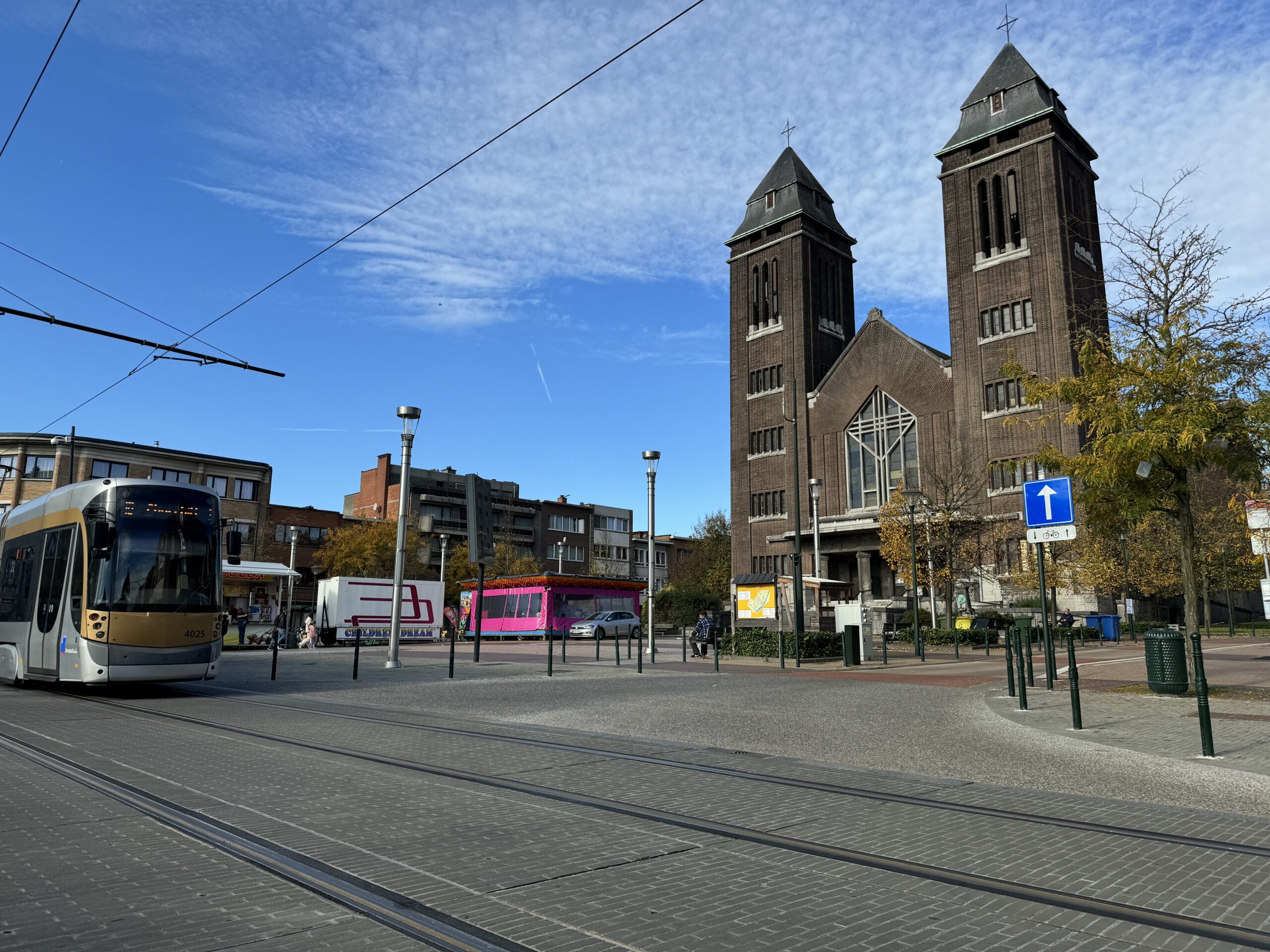It is not often that Brussels builds a new tram line. Tram 10, inaugurated by King Philippe in September, connects the northern neighbourhood of Neder-Over-Heembeek to the rest of the city.
Neder-Over-Heembeek is a strangely cut-off part of Brussels, hemmed in, as it is, by the ring road to the north, the canal to the south and the old A12 to Antwerp.
An outlying village of medieval Brussels, it bears the distinction of having the oldest recorded name of any place in the Brussels area – 7th century no less. Two parishes developed around two churches: Neder (lower) and Over (upper) Heembeek. The communities were combined in 1814, but rather than settle for the simple Heembeek name, each opted to keep their prefixes; and so the village became Lower-Upper Heembeek.
Heavy industrialisation along the canal-side, being forcibly subsumed into the commune of Brussels in 1921, and having neither a railway station nor a tram service all helped create a certain sense of isolation.
Strolling around the town centre one Wednesday, the village-y atmosphere was palpable: young children walking home from school on their own, a modest restaurant with unreconstructed and unironic 1940s decor serving very standard Belgian fare, people stopping to talk casually in the street, in a crowded café, the barman taking the time to get a social update from every customer who enters, and perhaps a bit more Dutch than elsewhere in Brussels.
The Brussels transport company STIB-MIVB, the Brussels commune, and NOH (as it is widely known) residents, all partook in a plan to create a new tramline, with 10 new stops from the A12 (Heembeek) up to the very top of the hilly village at the Military Hospital hard by the ring road.
This involved much gentrification of the main route through the town, trees being planted, wildlife access improved, and state-of-the-art tram stops (easy access for the disabled and mothers with baby buggies). All this was done in record time and ahead of schedule.
I was cordially invited to ride the inaugural tram 10 journey with none other than King Phillippe.
Let me qualify that. He rode in the first tram with his entourage and we toilers in Grub Street followed behind in another.
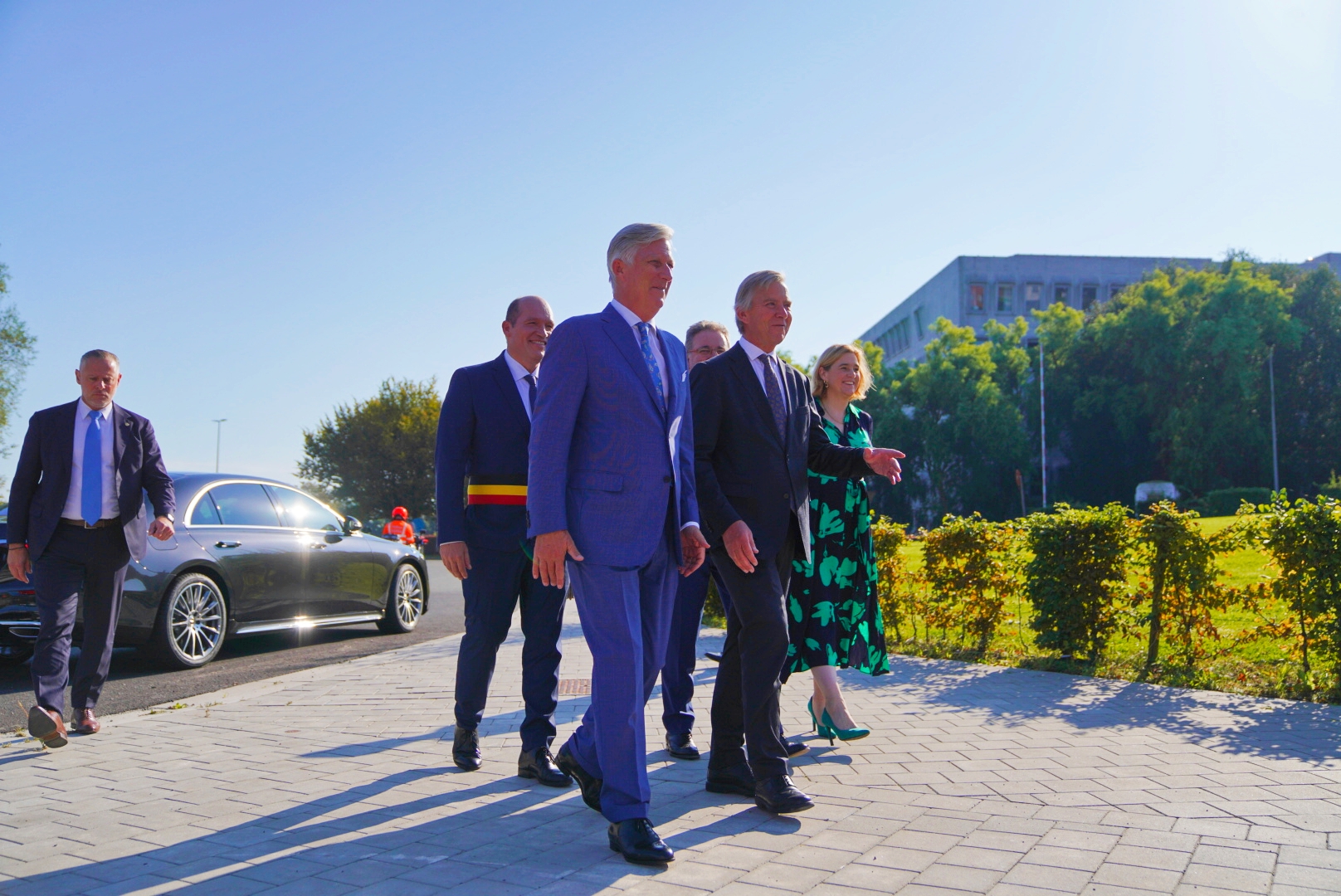
King Philippe of Belgium at the inauguration of tram line 10.
It was a beautiful Indian summer’s day in late September, the air still and the sky clear, as we waited at the glistening, new terminus at the Military Hospital in Neder-Over-Hembeek. The journalists, slightly untidy with their spiral notebooks and cameras hanging off them, and the courtiers, by contrast, looking very county indeed, stood quite separately at either end of the platform.
The sun shone, the traffic thundered around the ring road, a small crowd of curious onlookers gathered, and the Mayor of Brussels, Phillippe Close, crossed the divide between the First and Fourth Estates and worked the crowd - shaking my hand en passant but not giving me time to say who I was - or perhaps I lacked the presence of mind!
The King arrived with his entourage on time and at great speed, was greeted by the mayor, and climbed into the first tram without further ado.
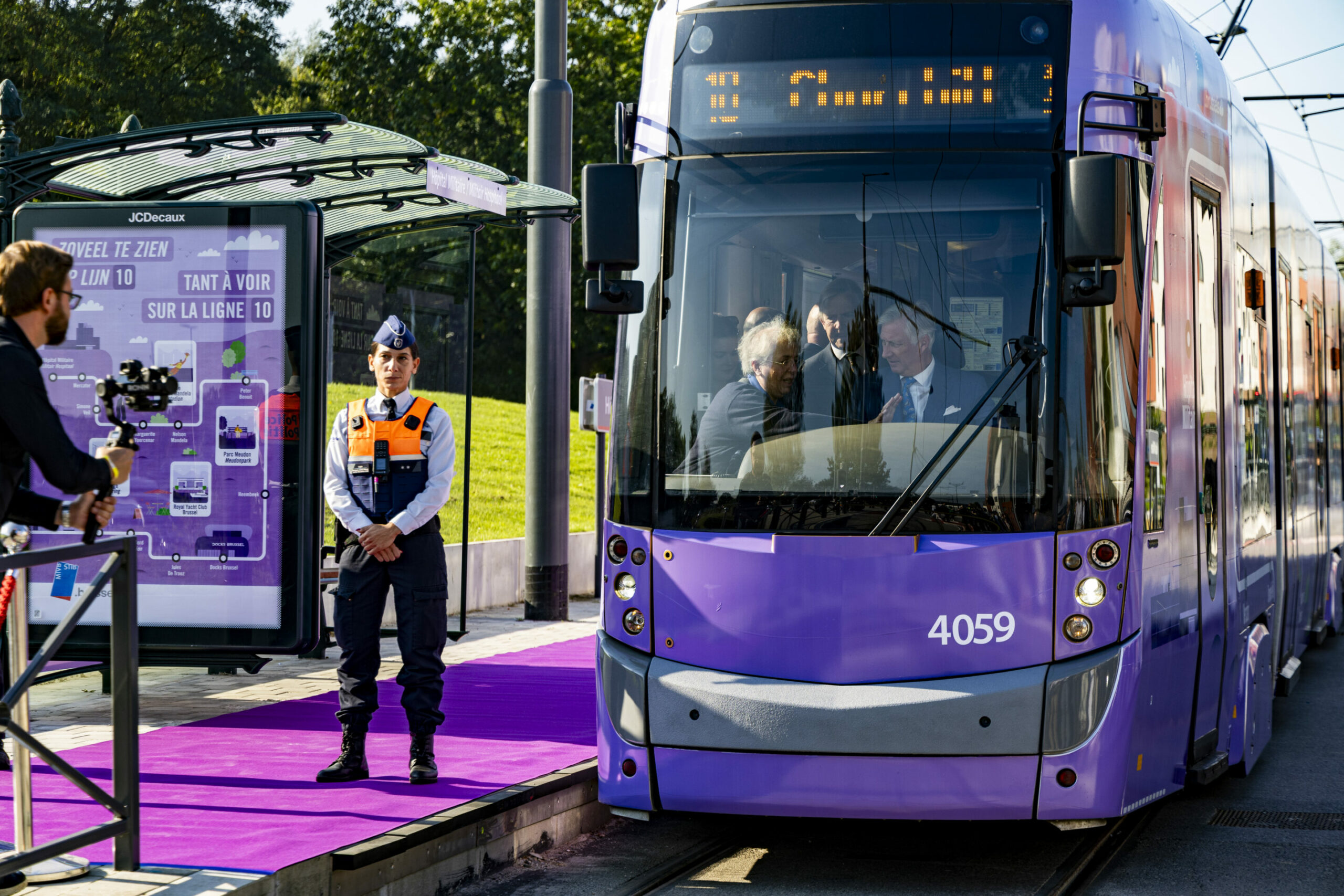
King Philippe drives a tram during a royal visit to the inauguration of the new tram line 10. Credit: Belga / Nicolas Maeterlinck
I later read that the King was at the controls. Technically His Majesty, indeed all of us, simply travelled the first four stops and then, well, stopped. This took us to the centre of Heembeek. Onlookers lined the way sporadically and clapped as the trams went past; a novel experience for me. I resisted waving. There was a festive crowd in the main square and the entrepreneurial local frituur/friterie had opened early. Involving the residents in the whole project clearly paid off.
As for me, I decided that the best way to experience the new line was to do the whole journey from Churchill at the other end and thus work my way back to the north.
Start again at Churchill
The weather had turned autumnal by the time I got around to it. Churchill, deep in Uccle, has a slightly curious arrangement whereby trams pass right through on the diameter of the roundabout while a brace of 10s await custom on the circumference.
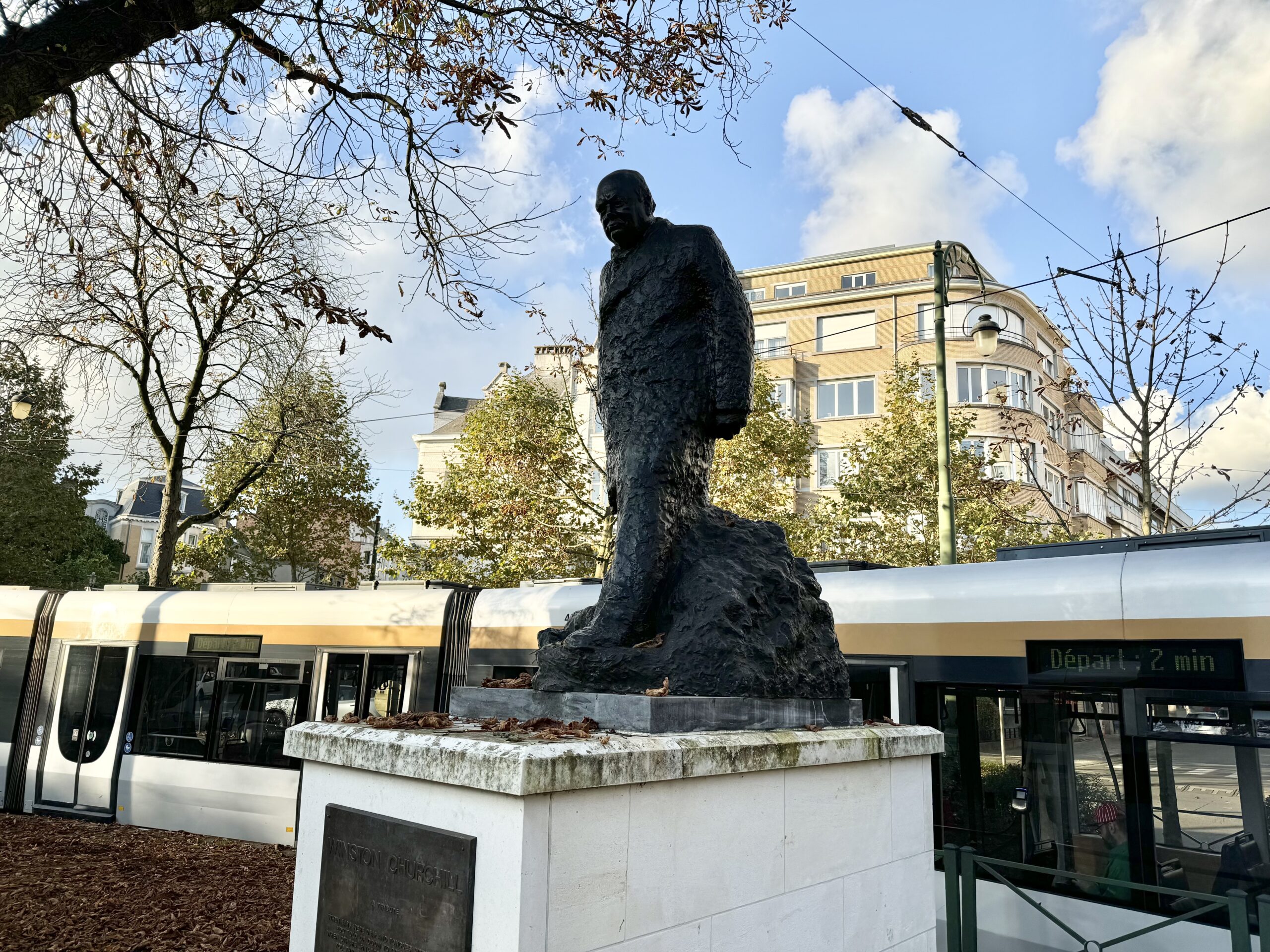
The Winston Churchill terminus in Brussels.
The first stop is Vanderkindere, a longish street for which I have a certain affection. It is littered with smart clothes shops, small restaurants and delicatessens to die for. There is something heart-warmingly European about a de facto open-air mall, otherwise known as a street, with lots of small shops - not outlets - which have simply evolved organically from the days when people bought locally. Always worth a stroll.
The tram then heads down the middle of the handsome. tree-lined Avenue Albert, which boasts grand Art Nouveau and Beaux-Arts mansions, before plunging underground at the eponymous Albert station. For the next four stations, the tram appears to be taking a Stygian plunge ever deeper to the centre of the Earth. In fact, the topography above is steadily downhill and the tram simply follows the trajectory. Some of the stations here are quite beautiful. Albert itself is white tiled (and has the unique distinction of having a platform on a slope), Parvis de Saint-Gilles-Sint-Gillisvoorplein blue and Porte de Hal-Hallepoort red. And then there is Midi-Zuid Station.
That the Midi tram station lacks the elan of some others is fitting enough. The railway station above it is not a welcoming place. The main hall is dark and gloomy, the shadows an invitation to the indigent, the outlets perfunctory and corporate and the policing lacks leadership (there is confusion about who’s in charge). To make matters worse, the areas outside are often bleak spaces without charm or commercial endeavour. None of this is helped by the never-ending works on the new metro line 3 station just nearby.
There are increasing calls for something to be done about it. After all, this is where international passengers arrive from the jazzed-up Gare du Nord in Paris and the magnificently restored St Pancras in London with its hi-tone shopping. I am deeply proud of my adopted city - but there is work to be done!
Talking of work done, the tram passes under Boulevard Anspach. This area has been mightily improved, is no longer traffic-clogged and has horse-trough-shaped mini-flower gardens here and there. Place Broukère-De Brouckèreplein has been likewise cleaned up and is a much more relaxing place to be. I can thoroughly recommend taking public transport into the city centre on a Saturday night, wandering around, looking for something toothsome to eat and drink, possibly visit one of the three multi-screened cinemas in the area, or even one of the three legit theatres if you speak French or Dutch. All are well within easy walking distance.
I recall an elderly French lady, brought up right on the border with Belgium before the Second World War, telling me that back in the day they looked up to Brussels as une ville sortante – which more or less translates as a buzzy town. As the city elders slowly squeeze the car from the centre of the city, perhaps her ghost will be nodding in quiet approval.
At the Bourse, if so inclined, you may exit and visit Belgian Beer World housed in the 1876 Stock Exchange. The bar at the top is spectacular with its view over Brussels’ medieval centre – a view to which no 14th century ‘ketje’ could possibly aspire; not least because the building wasn’t there!
Canal cruise
At Gare du Nord-Noordstation, the tram emerges from the tunnel and runs parallel, first to the railway embankment, then to the canal.
The Mabru tram stop, halfway along the tram’s sojourn beside the canal, is a syllabic abbreviation for Market Brussels. This is because, on the other side of the road from the water, there is a 14-hectare site which houses something rather magical. It is Brussels’, and indeed Belgium’s, principal wholesale food market.
It moved from the Grand Place, where it had been since time immemorial, only in 1973 and now comprises some 110 businesses and welcomes about 22,000 customers a week. It trades in fruit, vegetables, meat, fish, flowers, wine – pretty much anything comestible – with people in the trade. It opens, depending on the day, from midnight through to 16:00 and closes only on a Sunday.
Merchants come to Mabru from not only all over Belgium but northern France and southern Netherlands as well. Visitors are welcome under certain strict conditions (Horeca students only in their fifth year of study, says the website severely - so no dilettantes, then) and with a guide. Not as romantic as its Grand Place predecessor, perhaps, but far more practical.
Abutting this, and at the next stop up, is Docks Bruxsel - a newish, mid-level shopping centre. It prides itself on its green credentials with solar panels, rainwater collection for plants and cleaning, and a roof which can ventilate in the summer. More importantly, it is well served by trams 7, 3 and, of course, now 10. The stores are standard high street but the eating choices are extensive and imaginative. Further, there is a cobbled courtyard at canal level which, as I rushed through last week, seemed both characterful and fun with its street food stalls. It has a cinema (White) with eight screens and a sittable-at bar. On my visits there when I lived nearby, I found it efficient, clean and friendly.
The tram then swings over the canal and reaches the stop Heembeek where it veers right into Heembeek proper. This is the first of the new 10 stops climbing up the hill to the Military Hospital. I get off at the main square, Peter Benoit, dominated by New Church of Saint Peter and Paul, a striking 1935 Art Deco construction.
Castle, hospice and warehouses
I wander down the hill to a small park by the canal. It comprises the old grounds of the 17th century castle, the Château de Meudon, now long demolished and its ruins turned into Park Meudon. A small village just outside the capital must have been an uncomfortable place to be as it violently changed hands between the Spanish, the Burgundians, the Austrians, the French and the Dutch. The need for robust defence was self-evident.
Indeed, just two streets away, a small church on a cobbled hill deserves mention: Saint-Nicolas, built in the Baroque style in the 17th century after the original 12th century church was destroyed by troops in 1489.

Saint-Nicolas church.
On this wettish day, when I strolled through the park, it was a haven of quiet: 10 acres of glistening, dripping trees. Google Maps appeared to indicate large buildings between the park and the canal. I follow a finger of green to the thundering canal side road. There, somewhat to my surprise, is a massive warehouse, with some 15 loading bays half-a-dozen of which have lorries at them, belonging to Médecins Sans Frontières (MSF). Not only that but the grass verge, between the fence and the road, has been recently rewilded. I raise my eyes to salute the kindly gods of charitable endeavour.
At the north end of this 500-metre-long building is a weird structure, a sort of tower made of red brick. Not defensive but some kind of 17th century warehouse, I’m guessing. The windows and doors have all been blocked up and information is not to be had. The structure is slowly being covered with ivy and serves as a ghostly reminder of how long the Brussels area has been a major commercial centre. Round the back of it is a 1950s office building with a couple of cars parked outside. It is the Brussels and Brabant Food Bank warehouse. Heembeek appears to be a focal point for charitable distribution.
I wander uphill along a weed-strewn cobbled road to a 12th century tower which used to belong to the original church of Saint Peter and Paul. Unfortunately, the church itself was struck by lightning in 1932 and burned to the ground (hence the new one in the main square). There is some archaeological evidence of an even older building. This is remarkable as before the 12thcentury, most churches tended to be wooden.
On the edge of the park, there is a neat little structure which looks a bit like stables - regular doors three metres apart. It is, in fact, the 15th century Hospice of the Five Wounds of Christ which was neatly restored in the 1960s. It never occurred to me that there were hospices in medieval times – or maybe I had just never thought about it. So much history and so many good works hidden around every corner.
Related News
- Free public transport across Brussels on New Year's Eve
- 'Have you been good this year?' - Then you can ride the Christmas tram
I climb back on the tram to travel to its destination: the Military Hospital on the summit of the hill, over Over-Heembeek if you will. It skirts the sizable, one square kilometre nature reserve calling itself Val du Bois du Beguine/Begiunenbosdaal.
This used to belong to the Grande Beguinage de Bruxelles and in the 18th century was home to small farms, scattered woodlands and vegetable gardens for the local Heembeek villages. Rapid industrialisation along the canal in the late 19th century led to better wages and the abandonment of marginal land. The area was rewilded before anyone knew the term and serves as a lung of green right inside the Brussels ring road.
It also links up seamlessly with Vilvoorde’s much larger Drie Fonteinen park across the language border in Flanders. This helps the biodiversity of both flora and fauna neither of which are greatly bothered by linguistic niceties.
Soldiers and radiology
At the final stop, I walk up to the Military Hospital the main entrance of which is but 20 metres away. I enter unchallenged by the fatigue-clad soldiers at the front desk and head for the Belgian Museum of Radiology which is sign-posted with unmilitary lack of clarity.
The museum exhibitions were largely closed off but I did learn something about the X-ray pioneer, Wilhelm Conrad Röntgen. He discovered X-rays in December 1895 after seven weeks of assiduous work during which he had studied a new type of radiation able to pass through solids. He named them X-rays to underline the fact that their nature was then unknown. His wife and test subject, on seeing the skeleton of her own hand, shouted in alarm “I have seen my own death!”

The Military Hospital terminus.
I was also aware that somewhere in this large edifice is a state-of-the-art burns unit. This demands a constant temperature and humidity in the 26 rooms capable of handling serious cases. The hospital will accept civilians when necessary – as indeed it did during the pandemic when it provided quarantine wards.
The new line is exciting to think about. Here are 10 tram stops built not merely to carry people but to revive a community. Ease of transport means better-paid jobs and better access to the cultural, sporting and quaffing opportunities which a large city can offer. The economic effect on Heembeek should be wholly beneficial. And – whisper, who dares? - maybe in a couple of decades the good citizens of NOH might say to the échevins of Brussels, “Ehm, excuse me. Could we maybe, if you don’t mind terribly, sorry for asking, maybe get our commune back, please? Pretty please! If it’s not too much trouble.” Who knows?

